When you think about it, conversations are really powerful. They can make or break relationships, careers, even lives.
And they can certainly make or break your business.
The problem today is so many companies aren’t having the conversations they need to have with their audience. This is an issue because the uncomfortable truth is that most of us do not come across to our customers the way we intend.
You may see yourself one way, but a new audience member who’s just being introduced to your brand certainly doesn’t see you the same way. And that’s why Messenger Marketing is so critical: it helps you and your audience get to know one another. They lay the groundwork for trust, which is absolutely essential if you to build a profitable Facebook ecosystem.
Here’s what we’ll cover in this post:
- The Importance of Conversations in Marketing
- 3 Rules for Creating Successful Conversations with Customers
- Introducing: The Facebook Ecosystem Funnel
- Putting Together Your Facebook Funnel Ecosystem
- What Facebook Custom Audiences You Need
The Importance of Conversations in Marketing
It is super powerful what can happen to your brand when you start asking the right questions and making conversations— which you’ve probably figured out if you’re here :).
Let me show you an example of how this translates into trackable, real-world results. I’m about to share some stats from two different Facebook pages.
Now, be aware that these pages have a lot in common. They’re similar sizes, and they both do Facebook Live as their primary method of posting. They each post about one Live per day.
So here’s the first page:
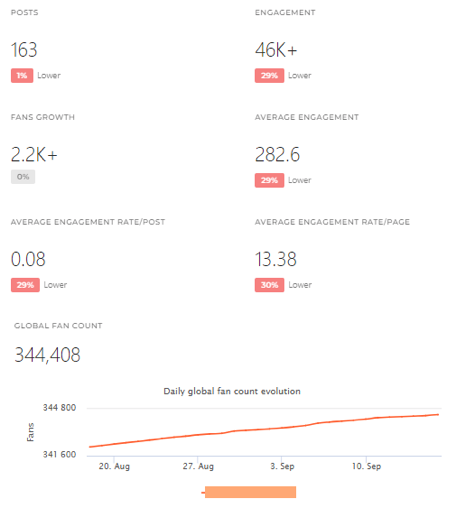
And here’s the second:
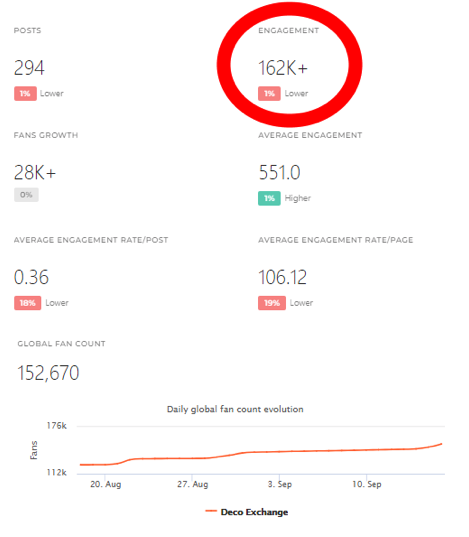
Woah, right?
Compared to the first page, the second page’s engagement is off the charts:
- 12x higher fan growth
- 2x better engagement
- 4.5x higher engagement rate/post
- 8x better engagement rate/page
So, what’s the difference between these two pages?
The second one uses a growth tool on their Lives to encourage conversations, and the first one doesn’t.
And these aren’t just vanity metrics. These high engagement numbers on the second page lead directly to real-world revenue.
The owner of this page sends out a message to his audience announcing his Live broadcasts, and those messages have an open rate of 90% or higher. Whenever he does that, his Live audience instantly jumps by 1,200-2,600 people. As a result, each of those Lives results in about $3,000-$4,000 in sales.
About 18 months ago he had 650 Facebook fans. And he grew that number to 152,670, in under 18 months, all because of Facebook Messenger chatbots.
So… how do you get results like that using Messenger Marketing? Like I said, you need to make sure you’re having conversations. And to do this effectively, your Messenger conversations have to follow 3 important rules.
3 Rules for Creating Successful Conversations with Your Customers
Think of these rules as the underlying principles that all businesses must follow in order to have customer conversations that result in sales.
Rule #1: Help Your Customers Identify Themselves
When you talk to your customers, it’s not about you or your product. If you think it’s all about you, you’re going to have to get over that mentality. It’s NEVER about you.
If you want to have meaningful conversations with your customers, get them to talk about themselves. That is how you will get people to convince themselves to buy your product or service.
Rule #2: Focus On Conversation Before Conversion
People aren’t going to trust you enough to buy from you until you’ve had a conversation with them first. So don’t be in a rush.
Think of this like dating. If a guy or girl came up to you on the street, out of nowhere, and asked you to marry them…would you do it?
Of course not!
You need to get to know each other first. And while buying a product isn’t THAT big of a commitment (at least compared to marriage), it’s still a commitment, and people aren’t going to make it without getting to know you a little first.
Rule #3: Follow The Rules Of 7s Before You Sell
Before someone is mentally ready to buy from you, you need to engage with them 7 times. Any sooner than that, and your conversion rates will be super, super low, because the person simply won’t trust you. You’ll also end up turning away a lot of people who would have bought from you, if only you’d taken things a little more slowly up front.
And this applies to ANY sort of transaction—even joining your mailing list!
If you ask for someone’s email too soon, chances are they won’t trust you. They don’t know if you’re going to spam them, or how often you’re going to email them. As a result, many people will either (a) refuse to join your email list or (b) join using a fake email address.
That’s why I don’t even bother asking for someone to subscribe until they’re farther along in the journey.
Now you may be wondering: 7 times? That sounds like a lot! How do I actually get someone to engage with me 7 times?
Here are some tips on how to do just that:
1. Create Irresistible Content
This is the prerequisite. People actually CAN’T interact with you multiple times unless you have multiple pieces of content for them to interact with.
So create content.
And this can’t just be any content—it has to be irresistible. Why? Because people today are exposed to so much content that nobody will bother to engage with run-of-the-mill content.
Creating video is recommended, because that tends to generate more engagement than text. And remember that this content should ideally help the reader/viewer to identify themselves.
2. Include An Incentive To Engage
Now that you have some irresistible content, give people a little extra incentive to engage. This could be something really simple—such as saying in your video, “Hey! Leave a comment and I’ll send you my notes.”
Others have offered to send a detailed tutorial of the demonstration from the video, a list of the materials or tools used in the video, etc. The best chatbot examples come up with a little something extra and give it to people who engage with your post.
And of course, use the Comment-to-Messenger Growth Tool to add those people to your ManyChat subscriber list.
3. Promote The Content
To get the ball rolling, put a little money behind your content to get it in front of people. Otherwise you run the risk of being hamstrung by a limited reach.
4. Create A Custom Audience
Create a new audience of people who engaged with that piece of content. This is how you’ll keep track of who has engaged with you, and how many times.
5. Rinse And Repeat 6 More Times
At this point, you have an audience of people who have engaged with you once. So to grow that number of conversations from 1 to 7, just do it all over again 6 more times! Simple, huh?
6. Watch One, Get The Rest
Here’s one strategy that is really effective for getting to 7 interactions: as soon as someone engages with one piece of content, automatically follow up and give them another piece.
Basically you’re just saying, “Hey, you seemed to enjoy my first video. Here’s another one you might like.”
Then when they engage on that content, do it again!
7. THEN…Go For The Sale
And now you can go for the sale. AFTER you get those first 7 engagements—and not before.
OK, so now that we have those underlying rules out of the way, let’s look at the step-by-step process that I use to accomplish this. And to do it, I’ve created a system that helps me to manufacture a high volume of productive conversations with my audience.
Introducing: The Facebook Ecosystem Funnel
Before I explain The Facebook Funnel, let me just show it to you first:
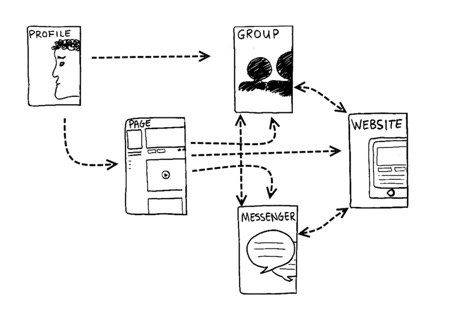
Right off the bat, you’ll notice that this creates a lovely little cycle where everything is interconnected. Which is great, because that makes it really fast and quick to get those 7 contact points you need before someone will buy.
There are 5 parts to the Facebook Ecosystem (6 if you want to count email – which is not dead by the way):
- Your personal profile
- Your business page
- Groups
- Your website
- Messenger
Now let’s dive into each part and explain how it fits into the bigger system.
Facebook Ecosystem Part #1: Your Personal Profile
Let’s talk about your profile. And I’m talking about your personal profile here—not your company page, author page, etc.
So what’s the goal of your personal profile? Simple: to establish trust with your audience.
Keep in mind that people do business with people, not with companies. For proof of this, look no further than car dealers. People won’t trust a car dealer… but they WILL trust one specific person at that company who was genuine and helped them out when they were shopping for a car.
Make sense?
So by letting people see you as a person, you’re making it easier for them to identify with you
That’s why you also need…
Facebook Ecosystem Part #2: Your Business Page
We just talked about why your personal profile is important. But you still need a business page, for a lot of reasons.
A business page is required to run ads, target people, create Facebook Custom Audiences, use Messenger growth tools, track pixel fires, and so on. It’s an essential piece of the Facebook Funnel.
Facebook Ecosystem Part #3: Groups
I love groups. Groups are a great place for you to connect and build trust with people who are in your space. If you’re active in your groups, they can be a great source of new Messenger subscribers and new traffic to your website.
They also help you interact with people faster, because they’re conducive to that back-and-forth interaction. People love to know that behind your brand is a real person, and they really enjoy getting to interact with you one-on-one inside that group.
Groups can also be a HUGE source of social proof when you’ve got group interactions going on, and people get to see all the other comments, likes, and shares you’re getting from people in your space.
Now groups do have some limitations. You can’t target them with ads, at least not directly, and you can’t create a custom audience directly from your groups. You’re also limited to the Messenger Referral URL with ManyChat (again, at least inside the group directly).
With all those limitations, how do you make groups work for you?
The trick is to use groups to give value. Every message to your group should be a value gift, not a pitch, so that people in your group feel very safe connecting with you on Messenger.
So don’t try to sell directly in your group. Instead post links to valuable content that gives people value, and from there, you can continue to retarget them. Eventually you can sell to them later using a Facebook ad, email, or Messenger.
Facebook Ecosystem Part #4: Your Website
When it comes to your website, the goal is traffic.
With that goal in mind, you need to make sure all your website traffic is being pixeled. That way, you can measure your traffic accurately, retarget people who visit your site, and create custom audiences.
Here’s another tip I really like: Add Messenger to your website for customer service. This way, you can retarget people who have come to your website and asked questions about your product or service.
It also helps you do a better job of tracking your interactions with people so you can stick to the Rules of 7s.
Facebook Ecosystem Part #5: Messenger
So where does Messenger Marketing fit into this ecosystem?
For me, Messenger is a value delivery mechanism. I use it to give, give, give to my audience. It’s never the place where I ask them to buy.
I want my audience to view Messenger as almost a sacred space. I want them to trust that I’m never going to spam them there. And I want them to feel like they’re getting so much value from me in Messenger that they can’t help but continue to open and read my messages there.
In fact, I’m so cautious about this that I don’t sell in Messenger. EVER. Even when it’s inside of that 24-hour period when you’re allowed to be promotional.
Instead, once I get those 7 engagements from people I will sell to them by retargeting them with a Facebook ad. That way I can keep Messenger a pristine space with no hint of promotion.
You don’t have to go that far—you can definitely link to you sales pages from Messenger if the person has engaged with you 7 times first. Just remember not to give that link unless the person asks for it. Never, ever, ever be spammy on Messenger. You should never be spammy anyway, but ESPECIALLY on Messenger.
Putting Together The Facebook Funnel Ecosystem
OK, at this point we’ve covered all the individual parts of the Facebook Funnel. So now let’s explore how these pieces interact and fit together to form the Facebook Funnel Ecosystem.
First things first, your page is what drives the traffic to your groups, Messenger, and your website.
Here’s what that looks like:
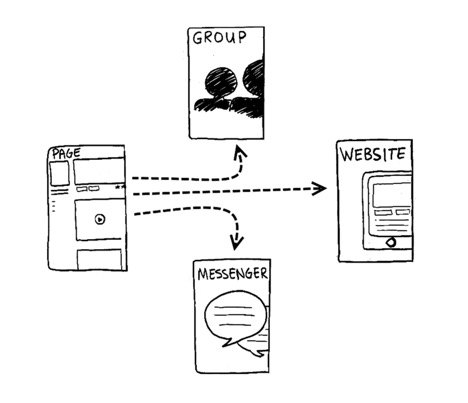
Because remember, your page is the only place where you can create custom audiences and run ads. So your page is what gives you the ability to tap into those custom audiences and retarget them with additional content.
And after somebody engages with you, and enters into the system, these 3 elements on the right (your group, website, and Messenger) are all reinforcing each other. Remember that your audience is not in just one place, so you shouldn’t be either.
Like this:
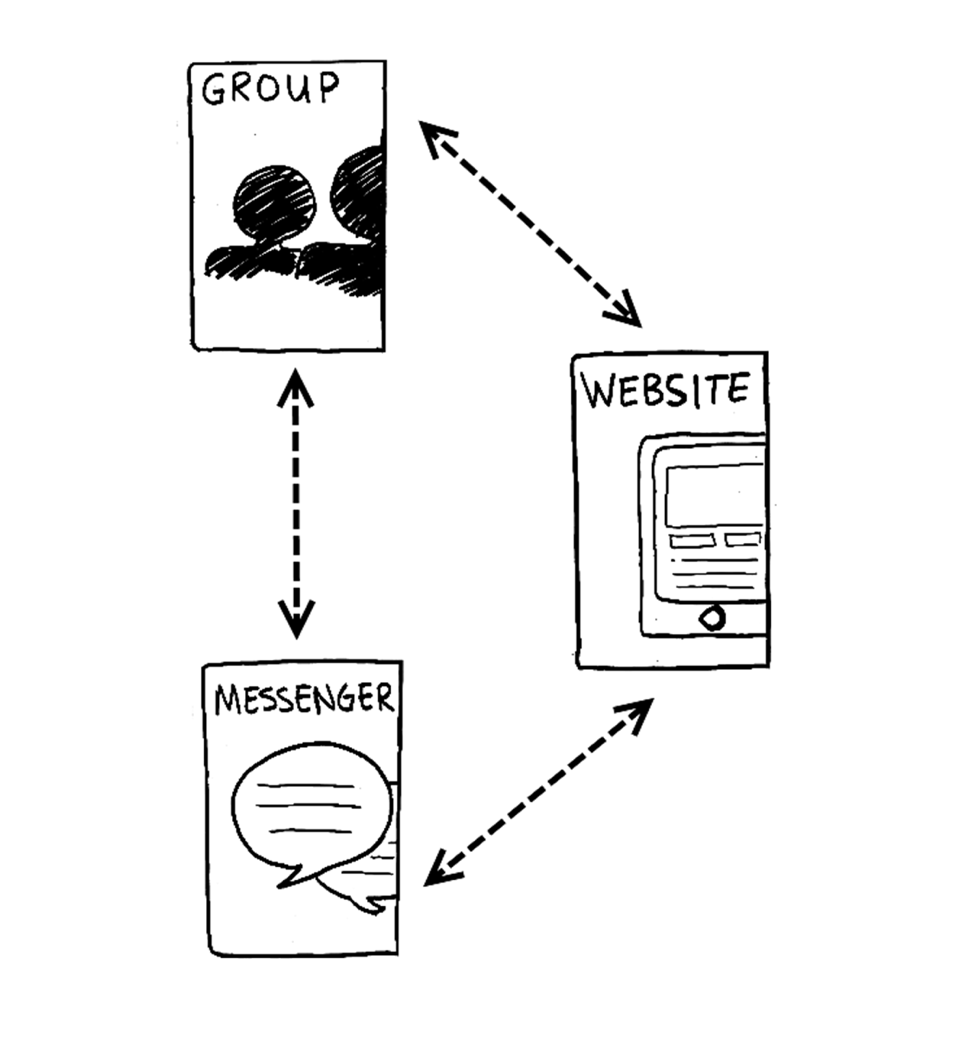
I want people to be having conversations with me across all 3 of these locations, and not just one. Because this reinforces multiple touch points, which helps us to get those 7 interactions a lot faster and easier than if we were only using one channel.
And when you combine those last two images together, and throw in your personal profile (which is connected to your page and your group), you get the Facebook Funnel Ecosystem:
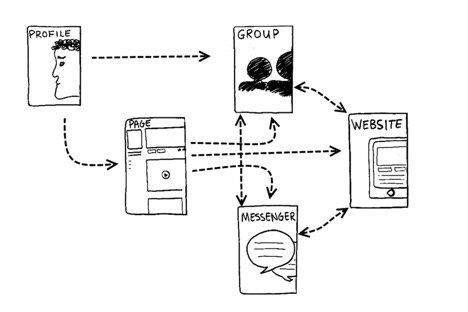
Now that we’ve gone through every piece of this funnel, you should understand the purpose of each part in it and how they’re all connected together.
To make this Facebook Funnel work for you, you just follow this framework! So when you have a piece of content to post, you’ll want to…
- Post to your personal profile
- Post to your page
- Share from your page into your group
- When they engage with that content, they get a message from your bot
- From Messenger you send them back into your group
And just to reiterate: this cycle is NOT about selling. This Facebook Funnel is not about getting a quick sale.
Instead it’s about setting up a system you can use to regularly and predictably build trust and authority with people by getting them to engage with you on multiple pieces of content and across multiple different platforms.
Because the truth, guys, is that building up authority is the hard part. Not the selling. Once you have an audience that knows, likes, and trusts you, selling to them is easy! You can target that audience with a Facebook ad and your conversions will be very high.
And with this system, you don’t need a big list. All you need is to have the right people on your list, and send them through this funnel 7 times.
What Facebook Custom Audiences You Need
If you think of the Facebook Funnel Ecosystem like a car, the oil that allows this whole machine to run is your custom audiences.
Custom audiences really make it happen.
The most important custom audiences in this system come from your page, from your website, and from Messenger.
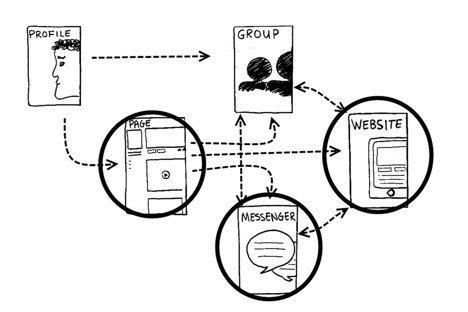
The good news is that even if you don’t have any custom audiences right now, you can get started with just these three. These are the three most important custom audiences you’ll want to focus on.
Facebook Custom Audience # 1: Page Engagement / Video Views
Track people who have engaged with your page. In many cases, video views will make up the majority of these interactions. I like to track 3 different video view goals: 3 seconds, 10 seconds, and 95% watched.
Facebook Custom Audience # 2: Folks Who Messaged Your Page
These people have asked for more information, and you know you can follow up with them.
Facebook Custom Audience # 3: People Who Visited Your Website
Keep track of people who have visited your website. Depending on how simple or complicated your website is, you may want to segment this down so you’re only tracking visits to certain pages.
Facebook Custom Audience # 4: For Bigger Audiences, Overlap These For The Best Conversion Rates
Now once your audience starts growing, the best way to increase your conversion rates is to overlap these audiences. Eventually, this is the direction you’ll want to go—by targeting people who have viewed a video AND messaged your page AND visited your website.
That’s a guaranteed hot audience and you can rest assured that a Facebook campaign targeting them is going to convert like gangbusters.
How To Get Started With The Facebook Ecosystem Funnel
When you look at something like the Facebook Funnel, it’s easy to get overwhelmed or feel like you have to do it all at once. So if you’re feeling that way, here are my parting words of wisdom for you:
Take one step. Drive people to one action at a time.
Don’t get overwhelmed by thinking, I have to do all of these steps in one post. If you try to do that, you’ll only end up confusing your audience. And a confused audience does not buy.
Buildings are built one brick at a time, and businesses work the same way. So don’t get overwhelmed. Just start with the first post, and focus on that until it’s done. And before you know it you’ll have a robust Facebook funnel that engages and builds trust with your audience.
ManyChat can help advance and convert leads in your Facebook Funnel. It’s free to get started.

Serial online entrepreneur and mom of six kids, Rachel has built audiences ranging in the millions. She has helped over 34 businesses grow the engagement on their content, allowing them to reach more than 10,000,000 people in a single Facebook post, and coaches over 25,000 small businesses and page owners in her group, Facebook Page Strategies. Rachel is a published author of multiple books including a best seller that sold more than 100,000 copies. She will show you how growing engagement on your brand is a formula, a skill that anyone and any product can have!





